Yihao Huang
Adversarial Attacks against Closed-Source MLLMs via Feature Optimal Alignment
May 27, 2025Abstract:Multimodal large language models (MLLMs) remain vulnerable to transferable adversarial examples. While existing methods typically achieve targeted attacks by aligning global features-such as CLIP's [CLS] token-between adversarial and target samples, they often overlook the rich local information encoded in patch tokens. This leads to suboptimal alignment and limited transferability, particularly for closed-source models. To address this limitation, we propose a targeted transferable adversarial attack method based on feature optimal alignment, called FOA-Attack, to improve adversarial transfer capability. Specifically, at the global level, we introduce a global feature loss based on cosine similarity to align the coarse-grained features of adversarial samples with those of target samples. At the local level, given the rich local representations within Transformers, we leverage clustering techniques to extract compact local patterns to alleviate redundant local features. We then formulate local feature alignment between adversarial and target samples as an optimal transport (OT) problem and propose a local clustering optimal transport loss to refine fine-grained feature alignment. Additionally, we propose a dynamic ensemble model weighting strategy to adaptively balance the influence of multiple models during adversarial example generation, thereby further improving transferability. Extensive experiments across various models demonstrate the superiority of the proposed method, outperforming state-of-the-art methods, especially in transferring to closed-source MLLMs. The code is released at https://github.com/jiaxiaojunQAQ/FOA-Attack.
A Vision for Auto Research with LLM Agents
Apr 26, 2025Abstract:This paper introduces Agent-Based Auto Research, a structured multi-agent framework designed to automate, coordinate, and optimize the full lifecycle of scientific research. Leveraging the capabilities of large language models (LLMs) and modular agent collaboration, the system spans all major research phases, including literature review, ideation, methodology planning, experimentation, paper writing, peer review response, and dissemination. By addressing issues such as fragmented workflows, uneven methodological expertise, and cognitive overload, the framework offers a systematic and scalable approach to scientific inquiry. Preliminary explorations demonstrate the feasibility and potential of Auto Research as a promising paradigm for self-improving, AI-driven research processes.
A Comprehensive Survey in LLM(-Agent) Full Stack Safety: Data, Training and Deployment
Apr 22, 2025Abstract:The remarkable success of Large Language Models (LLMs) has illuminated a promising pathway toward achieving Artificial General Intelligence for both academic and industrial communities, owing to their unprecedented performance across various applications. As LLMs continue to gain prominence in both research and commercial domains, their security and safety implications have become a growing concern, not only for researchers and corporations but also for every nation. Currently, existing surveys on LLM safety primarily focus on specific stages of the LLM lifecycle, e.g., deployment phase or fine-tuning phase, lacking a comprehensive understanding of the entire "lifechain" of LLMs. To address this gap, this paper introduces, for the first time, the concept of "full-stack" safety to systematically consider safety issues throughout the entire process of LLM training, deployment, and eventual commercialization. Compared to the off-the-shelf LLM safety surveys, our work demonstrates several distinctive advantages: (I) Comprehensive Perspective. We define the complete LLM lifecycle as encompassing data preparation, pre-training, post-training, deployment and final commercialization. To our knowledge, this represents the first safety survey to encompass the entire lifecycle of LLMs. (II) Extensive Literature Support. Our research is grounded in an exhaustive review of over 800+ papers, ensuring comprehensive coverage and systematic organization of security issues within a more holistic understanding. (III) Unique Insights. Through systematic literature analysis, we have developed reliable roadmaps and perspectives for each chapter. Our work identifies promising research directions, including safety in data generation, alignment techniques, model editing, and LLM-based agent systems. These insights provide valuable guidance for researchers pursuing future work in this field.
Privacy Protection Against Personalized Text-to-Image Synthesis via Cross-image Consistency Constraints
Apr 17, 2025Abstract:The rapid advancement of diffusion models and personalization techniques has made it possible to recreate individual portraits from just a few publicly available images. While such capabilities empower various creative applications, they also introduce serious privacy concerns, as adversaries can exploit them to generate highly realistic impersonations. To counter these threats, anti-personalization methods have been proposed, which add adversarial perturbations to published images to disrupt the training of personalization models. However, existing approaches largely overlook the intrinsic multi-image nature of personalization and instead adopt a naive strategy of applying perturbations independently, as commonly done in single-image settings. This neglects the opportunity to leverage inter-image relationships for stronger privacy protection. Therefore, we advocate for a group-level perspective on privacy protection against personalization. Specifically, we introduce Cross-image Anti-Personalization (CAP), a novel framework that enhances resistance to personalization by enforcing style consistency across perturbed images. Furthermore, we develop a dynamic ratio adjustment strategy that adaptively balances the impact of the consistency loss throughout the attack iterations. Extensive experiments on the classical CelebHQ and VGGFace2 benchmarks show that CAP substantially improves existing methods.
PATFinger: Prompt-Adapted Transferable Fingerprinting against Unauthorized Multimodal Dataset Usage
Apr 15, 2025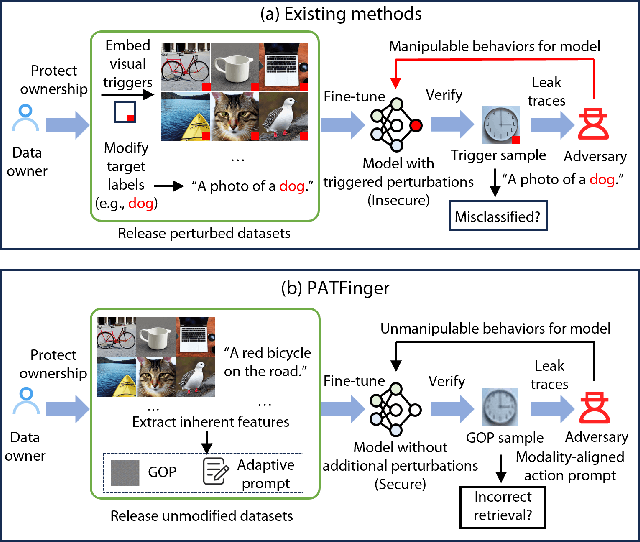

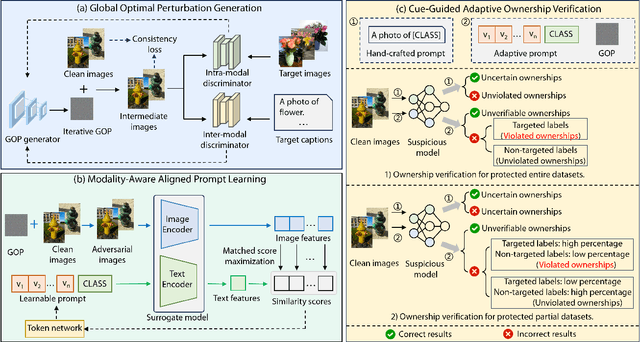
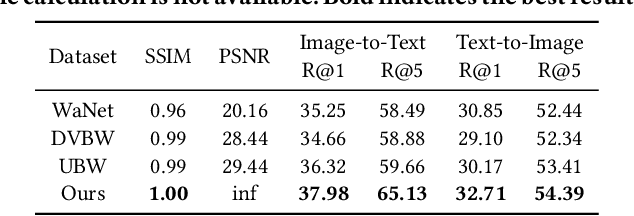
Abstract:The multimodal datasets can be leveraged to pre-train large-scale vision-language models by providing cross-modal semantics. Current endeavors for determining the usage of datasets mainly focus on single-modal dataset ownership verification through intrusive methods and non-intrusive techniques, while cross-modal approaches remain under-explored. Intrusive methods can adapt to multimodal datasets but degrade model accuracy, while non-intrusive methods rely on label-driven decision boundaries that fail to guarantee stable behaviors for verification. To address these issues, we propose a novel prompt-adapted transferable fingerprinting scheme from a training-free perspective, called PATFinger, which incorporates the global optimal perturbation (GOP) and the adaptive prompts to capture dataset-specific distribution characteristics. Our scheme utilizes inherent dataset attributes as fingerprints instead of compelling the model to learn triggers. The GOP is derived from the sample distribution to maximize embedding drifts between different modalities. Subsequently, our PATFinger re-aligns the adaptive prompt with GOP samples to capture the cross-modal interactions on the carefully crafted surrogate model. This allows the dataset owner to check the usage of datasets by observing specific prediction behaviors linked to the PATFinger during retrieval queries. Extensive experiments demonstrate the effectiveness of our scheme against unauthorized multimodal dataset usage on various cross-modal retrieval architectures by 30% over state-of-the-art baselines.
Evolution-based Region Adversarial Prompt Learning for Robustness Enhancement in Vision-Language Models
Mar 17, 2025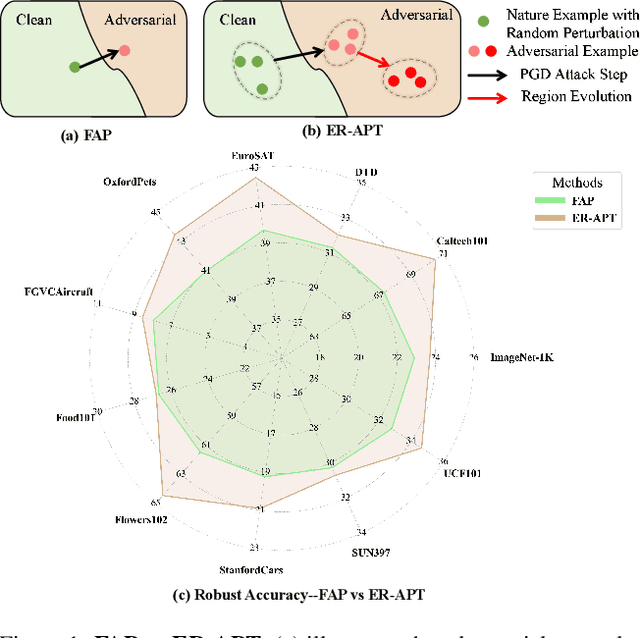
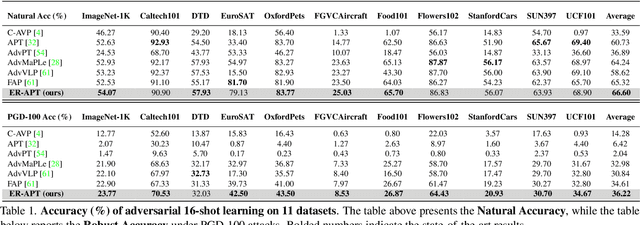
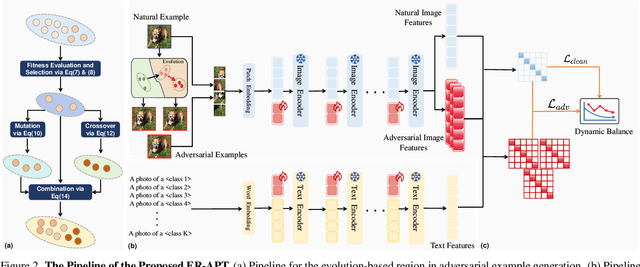
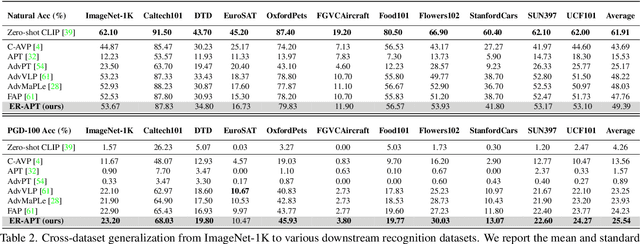
Abstract:Large pre-trained vision-language models (VLMs), such as CLIP, demonstrate impressive generalization but remain highly vulnerable to adversarial examples (AEs). Previous work has explored robust text prompts through adversarial training, achieving some improvement in both robustness and generalization. However, they primarily rely on singlegradient direction perturbations (e.g., PGD) to generate AEs, which lack diversity, resulting in limited improvement in adversarial robustness. To address these limitations, we propose an evolution-based region adversarial prompt tuning method called ER-APT, which combines gradient methods with genetic evolution to generate more diverse and challenging AEs. In each training iteration, we first generate AEs using traditional gradient-based methods. Subsequently, a genetic evolution mechanism incorporating selection, mutation, and crossover is applied to optimize the AEs, ensuring a broader and more aggressive perturbation distribution.The final evolved AEs are used for prompt tuning, achieving region-based adversarial optimization instead of conventional single-point adversarial prompt tuning. We also propose a dynamic loss weighting method to adjust prompt learning efficiency for accuracy and robustness. Experimental evaluations on various benchmark datasets demonstrate the superiority of our proposed method, outperforming stateof-the-art APT methods. The code is released at https://github.com/jiaxiaojunQAQ/ER-APT.
Scale-Invariant Adversarial Attack against Arbitrary-scale Super-resolution
Mar 06, 2025



Abstract:The advent of local continuous image function (LIIF) has garnered significant attention for arbitrary-scale super-resolution (SR) techniques. However, while the vulnerabilities of fixed-scale SR have been assessed, the robustness of continuous representation-based arbitrary-scale SR against adversarial attacks remains an area warranting further exploration. The elaborately designed adversarial attacks for fixed-scale SR are scale-dependent, which will cause time-consuming and memory-consuming problems when applied to arbitrary-scale SR. To address this concern, we propose a simple yet effective ``scale-invariant'' SR adversarial attack method with good transferability, termed SIAGT. Specifically, we propose to construct resource-saving attacks by exploiting finite discrete points of continuous representation. In addition, we formulate a coordinate-dependent loss to enhance the cross-model transferability of the attack. The attack can significantly deteriorate the SR images while introducing imperceptible distortion to the targeted low-resolution (LR) images. Experiments carried out on three popular LIIF-based SR approaches and four classical SR datasets show remarkable attack performance and transferability of SIAGT.
PromptGuard: Soft Prompt-Guided Unsafe Content Moderation for Text-to-Image Models
Jan 07, 2025



Abstract:Text-to-image (T2I) models have been shown to be vulnerable to misuse, particularly in generating not-safe-for-work (NSFW) content, raising serious ethical concerns. In this work, we present PromptGuard, a novel content moderation technique that draws inspiration from the system prompt mechanism in large language models (LLMs) for safety alignment. Unlike LLMs, T2I models lack a direct interface for enforcing behavioral guidelines. Our key idea is to optimize a safety soft prompt that functions as an implicit system prompt within the T2I model's textual embedding space. This universal soft prompt (P*) directly moderates NSFW inputs, enabling safe yet realistic image generation without altering the inference efficiency or requiring proxy models. Extensive experiments across three datasets demonstrate that PromptGuard effectively mitigates NSFW content generation while preserving high-quality benign outputs. PromptGuard achieves 7.8 times faster than prior content moderation methods, surpassing eight state-of-the-art defenses with an optimal unsafe ratio down to 5.84%.
Concept Guided Co-saliency Objection Detection
Dec 21, 2024Abstract:The task of co-saliency object detection (Co-SOD) seeks to identify common, salient objects across a collection of images by examining shared visual features. However, traditional Co-SOD methods often encounter limitations when faced with diverse object variations (e.g., different postures) and irrelevant background elements that introduce noise. To address these challenges, we propose ConceptCoSOD, a novel concept-guided approach that leverages text semantic information to enhance Co-SOD performance by guiding the model to focus on consistent object features. Through rethinking Co-SOD as an (image-text)-to-image task instead of an image-to-image task, ConceptCoSOD first captures shared semantic concepts within an image group and then uses them as guidance for precise object segmentation in complex scenarios. Experimental results on three benchmark datasets and six corruptions reveal that ConceptCoSOD significantly improves detection accuracy, especially in challenging settings with considerable background distractions and object variability.
What External Knowledge is Preferred by LLMs? Characterizing and Exploring Chain of Evidence in Imperfect Context
Dec 17, 2024



Abstract:Incorporating external knowledge into large language models (LLMs) has emerged as a promising approach to mitigate outdated knowledge and hallucination in LLMs. However, external knowledge is often imperfect. In addition to useful knowledge, external knowledge is rich in irrelevant or misinformation in the context that can impair the reliability of LLM responses. This paper focuses on LLMs' preferred external knowledge in imperfect contexts when handling multi-hop QA. Inspired by criminal procedural law's Chain of Evidence (CoE), we characterize that knowledge preferred by LLMs should maintain both relevance to the question and mutual support among knowledge pieces. Accordingly, we propose an automated CoE discrimination approach and explore LLMs' preferences from their effectiveness, faithfulness and robustness, as well as CoE's usability in a naive Retrieval-Augmented Generation (RAG) case. The evaluation on five LLMs reveals that CoE enhances LLMs through more accurate generation, stronger answer faithfulness, better robustness against knowledge conflict, and improved performance in a popular RAG case.
 Add to Chrome
Add to Chrome Add to Firefox
Add to Firefox Add to Edge
Add to Edge